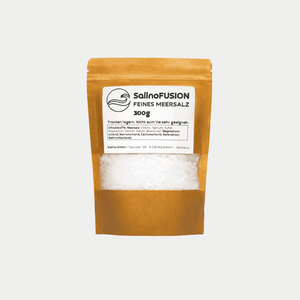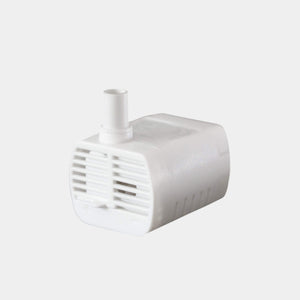Taking a breath in a world full of irritants
There are places where breathing suddenly becomes easier. On the coast, when the wind carries salty sea air across the land. In old salt mines, deep underground. Or in graduation towers, where brine trickles down blackthorn walls. Anyone who has ever been there knows this feeling: Your lungs open, your nose clears, your head clears.
What many describe as a soothing experience isn't just about vacation—it's about science. Salt air therapy, also known as halotherapy, is based on more than just tradition and anecdotes. In this article, we take a closer look at what salty air can do for the body—and what evidence there is to support it.
Because between romantic notions of sea breezes and clinical research lies a fascinating space. One worth exploring – for anyone suffering from asthma, allergies, bronchitis, or simply dry air from heating.
The Science Behind Salt: What Salty Air Actually Is
 Aerosols, osmosis and microscopic particles
Aerosols, osmosis and microscopic particles
Salty air contains tiny particles of sodium chloride – so-called aerosols – that can penetrate deep into the respiratory tract when inhaled. These particles are created naturally by sea spray or artificially by nebulizing saline solutions. In graduation towers, for example, saline solutions are atomized on brushwood walls, creating aerosols that are similar to natural sea air.
The key: These salt molecules bind water. When they enter the respiratory tract, they draw fluid into the mucous membranes and loosen trapped mucus—a purely physical effect described as osmotic. This can support the lungs' self-cleansing process.
Study situation: What is proven – and what is not
Some studies show that regular exposure to salty air can improve respiratory function in certain patient groups. This particularly applies to people with chronic bronchitis, asthma, or COPD. The German Respiratory League and the Lung Information Service report moderate effects on mucus clearance and cough reduction, especially with regular use.
A 2021 systematic review by the Cochrane Library reaches a mixed conclusion: While some studies show improvements in lung function, the overall data are still limited. Halotherapy is therefore not recognized as a medically necessary intervention—but is being discussed as a possible complementary therapy.
Why placebo is not enough here
Critics often cite the placebo effect—but in the case of salt air, this is only one piece of the puzzle. The measurable change in humidity and the chemical reactions in the mucous membranes cannot be explained solely by imagination. Animal studies also show, for example, anti-inflammatory effects from inhaling saline aerosols.
Whether halotherapy contributes to therapy or merely provides relief is a matter of individual preference. And this is precisely where the exciting part of the story begins: How do those affected experience the salt air? What role do duration, concentration, and environment play? And what does modern research say about this?
From caves to high-tech: How salt air comes into everyday life
 Natural healing spaces: spas, caves and graduation towers
Natural healing spaces: spas, caves and graduation towers
Since the 19th century, spa towns in Europe have deliberately relied on saline air. Places like Bad Salzungen or Wieliczka in Poland, with their graduation towers and salt mines, have established themselves as havens for respiratory patients. The highlight of these places is the permanently high concentration of saline moisture in the air, which in some cases resembles a marine-effect microclimate—only drier and cooler.
These so-called speleotherapies (from the Latin "spelunca," cave) have been observed, documented, and evaluated for decades. Although they are not covered by statutory health insurance in Germany, numerous reports and smaller studies demonstrate that they can contribute to the relief of chronic respiratory diseases—not as a substitute for medication, but as a natural supplement.
Modern technology: salt to go
But what if you don't live near a spa? This is where technological solutions come into play: so-called mini-salt baths or nebulizers, which promise a similar effect. These aren't humidifiers in the traditional sense, but rather devices that specifically produce saline microparticles.
The challenge lies in striking the right balance: Particles that are too large settle in the nose, while particles that are too small may have difficulty reaching the deeper lung tissue. Newer devices therefore utilize precision technology—such as swirling or 3D-printed microstructures—to optimize particle size. Such devices make it possible to integrate the therapeutic principle of halotherapy into everyday life—whether at home, in the office, or even at bedside at night.
Is that enough for the effect?
Whether the effect approaches natural conditions depends on several factors: salt concentration, duration of exposure, room size, humidity, and individual disposition. While graduation towers often have a concentration of 0.5 to 1%, high-quality home devices achieve up to 30% salt saturation at the micro level—which translates to a high aerosol density.
Here, too, studies show that regular, passive exposure—about 30 minutes a day for several weeks—can lead to positive changes. What's crucial is not only the technique, but also the consistency of application.
The effect on the body: Why salt is more than an expectorant
 Immunomodulation by saline aerosols
Immunomodulation by saline aerosols
In addition to the purely physical removal of mucus, other mechanisms are coming into focus, particularly the effect on the immune system. Initial studies indicate that salty air can influence the activity of cells of the innate immune system—such as macrophages and neutrophil granulocytes. This could explain why patients report a reduction in inflammatory processes in the airways.
The natural antibacterial effect of sodium chloride also plays a role here: salt can inhibit the growth of certain germs, which could be particularly beneficial in cases of chronic sinusitis or recurring infections.
Irritation or regulation? The fine line
At the same time, caution is advised. Not every lung reacts the same. In cases of acute infections or highly reactive airways, excessive salt concentrations can be irritating. The German Allergy and Asthma Association (DAAB) therefore recommends testing new devices or therapies under observation first – and consulting a physician if unsure.
In other words: Salt air is not a panacea, but a potentially effective component in the mosaic of respiratory health. Those who use it wisely can benefit from it – but blanket promises of healing are neither reliable nor helpful.
Salt air in everyday life: Who benefits – and how?
Respiratory patients between everyday life and therapy
In particular, people with chronic illnesses such as bronchial asthma, COPD, or pollen allergies regularly report positive effects from salty air. These range from easier breathing in the morning to more restful sleep and improved tolerance of physical activity. In interviews, many describe producing significantly less mucus, coughing less, and sleeping more soundly at night during periods of salt inhalation.
But healthy people also use salt air – for example, during periods of high particulate matter pollution, when irritated by dry heating air, or to recover from infections. Interestingly, it's not the medical diagnosis that's decisive, but rather personal experience with air quality.
Everyday suitability counts
Therapies that are complicated or time-consuming often quickly lose their relevance in everyday life. This is one of the advantages of halotherapy: It is quiet, unobtrusive, and requires no active intervention. There are no breathing exercises, no masks, no time pressure – salty air works through presence, not action.
Its passive application—e.g., during sleep or while working—is particularly appealing to many people. Instead of relying on motivation or routine, salt air can simply be integrated into one's living space.
Conclusion: A silent companion with a noticeable effect
Salt air therapy isn't a miracle cure. But it's also far more than just a seaside vacation. Scientifically speaking, it's based on real physical and biological mechanisms that can support the body's natural cleansing and regulation.
It doesn't replace medication, but it can provide a breathing space—literally—in a stressful daily life. For many, salty air is the small difference between a heavy breath and a free one, between constant irritation and soothing silence.
Those who want to enjoy the benefits long-term don't have to move to the coast or undergo expensive health treatments. Today, there are devices that specifically generate salty air – without changing filters, with low energy consumption, and quiet enough for the bedroom. One of these is the Mini-Saline from SalinoVatis: a compact way to bring a bit of salty coastal air into your home. No effort, but effective.
Medical note:
The information on salt air therapy presented in this article is intended solely for general information purposes. It is in no way a substitute for professional advice, diagnosis, or treatment by licensed physicians. Please always consult a medical professional if you have any health problems, especially in cases of chronic or acute respiratory diseases. The use of salt air—whether through natural or technical means—should always be assessed individually and, if necessary, supervised by a doctor.



